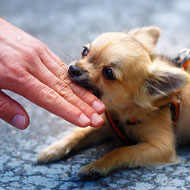YouTube videos offer insight into dog bites

Common dog breeds in the videos were Chihuahuas, German shepherds, pit bulls and Labrador retrievers (stock photo).
For the first time, scientists have used YouTube videos to learn more about the risk factors that lead to dog bites.
Researchers from the University of Liverpool used search terms such as ‘dog bite’ and ‘dog attack’ to find 143 videos, of which 56 showed details of the human and dog behaviour that led up to the bite.
Findings published in the journal Scientific Reports suggest that around seven in 10 of the bite victims in the videos were male, while over half were children or infants. Common dog breeds observed were Chihuahuas, German shepherds, pit bulls and Labrador retrievers.
Whilst the study did not explore the causal relationship between human behaviour and dog bites, tactile contact with a dog increased around 20 seconds before a bite, as did standing or leaning over a dog.
Researchers acknowledged that YouTube videos of dog bites are likely to be subject to some bias. For example, bites by small dogs may be perceived as ‘comical’ and therefore be uploaded online more frequently.
Despite this, researchers said their findings are consistent with previous studies, in terms of breed type and the gender and age of victims.
Lead author Sara Owczarczak-Garstecka said: “Online videos present us with an unexplored opportunity to observe dog bites first-hand, something which is just not possible using other methods.
“Making more use of this type of shared content for research could help us better understand how and why bites occur and contribute to the development of bite prevention strategies.”
The findings could also offer valuable insights for bite prevention strategies, by emphasising the risk of leaning over dogs.



 The RCVS has announced a new version of its 1CPD mobile app, with enhanced features for veterinary surgeons and veterinary nurses to record their continuing professional development.
The RCVS has announced a new version of its 1CPD mobile app, with enhanced features for veterinary surgeons and veterinary nurses to record their continuing professional development.